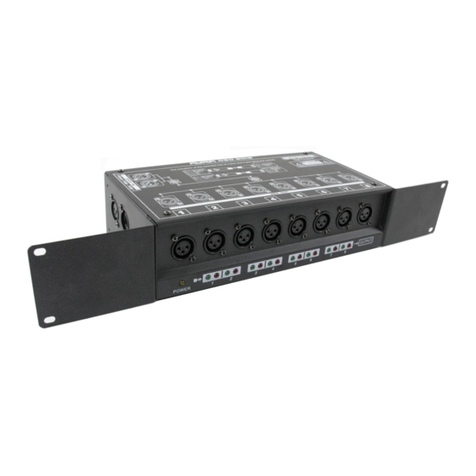- Al ays disconnect the device hen it is not in use for a longer period or time, hen servicing is needed, or
hen the device needs cleaning.
- Only handle the po er cord by its connectors. Never pull the cable to remove a connector from its socket,
as this could lead to damage and electric shocks.
- Al ays operate this device ith a stable AC current.
- Al ays operate this device ith the AC ground ire connected to the electrical system's ground.
- Never use other types of cables other than those specified in the manual, do not use defective or
malfunctioning cables. Contact your dealer if the included or required cables do not ork properly ith this
device.
- If the device has been exposed to considerable temperature changes (for example, transport from outdoors
to indoors), do not connect the device immediately. Do not activate the unit until it has reached room
temperature as moisture might build up inside the unit, hich may cause it to short-circuit and/or cause
electric shocks.
Guidelines and types of use:
- This device is intended to be used by adults for in locations such as community centres, bars, dancing
schools, roller skating rinks, bo ling alleys, theatres etc.
- This device is not suitable for use by children and must al ays be operated by an adult.
- Only use the device hen the environment is suitable and ill not cause any damage. Do not use the
product in damp or dusty environments, or here long-term damage may occur such as:
- indoor s imming pools here chlorine is used.
- beaches, here sand and salt are present.
- outdoors.
- indoor areas here intense heat sources are present or here the temperature exceeds levels that
are comfortable for humans.
- Use only the included po er cable and only connect the device to a suitable po er outlet ith the correct
output voltage. Connecting the device to a po er outlet ith the rong type of voltage or using the product
ith a rong type of po er supply may cause permanent damage to the device.
- Avoid shocks and collisions during use and transport. Do not transport the device hile in use. Avoid brute
force during the installation and operation of this device.
- Familiarise yourself ith the functions of the device before use. Do not allo operation of the device by
unskilled or unqualified people.
- Use of the device in ays other than described in this user manual may cause damage and injury. Ayra
cannot be held responsible for any damage or injury caused by improper use.
Storage and transport:
- This device is intended for mobile use as ell as fixed installations. During transport, use the original
packaging of the product, or a fitting flight case, preferably filled ith foam.
- If the device is not used for a longer period of time, disconnect it from its po er source and store it in its
original packaging, or in a fitting flight case.
- Store the device in dry conditions indoors, and do not expose the device to extreme temperature changes.
Housing:
- Inspect the housing of the device frequently. Severe dents, cracks and missing scre s should be prevented
at all costs. Do not use the device hen the housing is not in optimal condition. Contact your dealer or a
skilled technician hen in doubt about the state of the device.
- Check the fixture and scre s for corrosion. Corrosion should not be present on the fixture. Contact your
dealer or a skilled technician hen corrosion is found on the fixture.
- Every po er or signal chassis/connector should be mounted tightly. Do not use the device hen connectors
are loose.
- Do not use the po er adapter if the conductors are visible. The cable can not be replaced by the user and
should only be repaired or replaced by a skilled technician.
- Prevent the build-up of dust and dirt. Clean the exterior of the fixture every month ith a dry or damp cloth.
If the device is intensively used, the cleaning frequency must be increased. Disconnect the fixture hen it is
going to be serviced.
Fuses:
The main fuse of this product is positioned inside the unit and can not be replaced by the user. As this device
uses only little po er, the fuse ill only blo hen something is really rong ith either the device or the
The information and illustrations shown in this user manual are subject to change without notice.
User manual version: 2.0 Creation date + author initials: 27-01-2016 RV Revision date + author initials: 23-07-2016




























